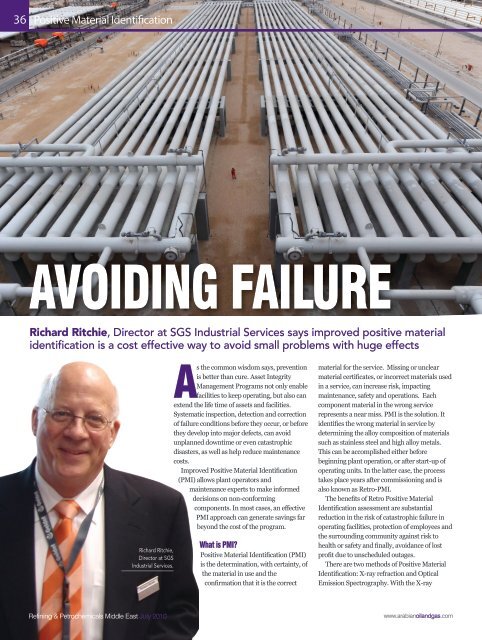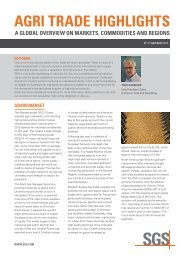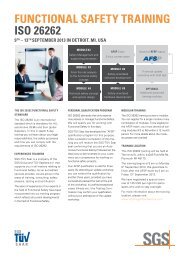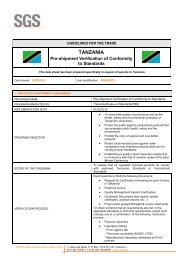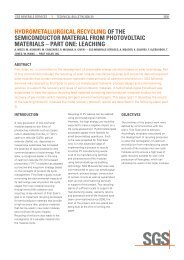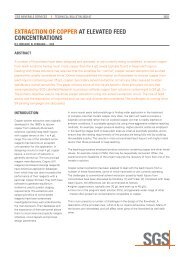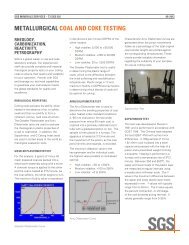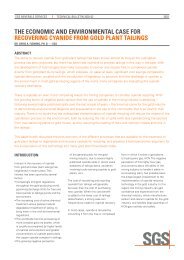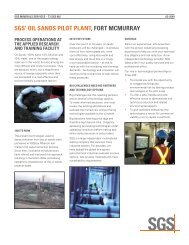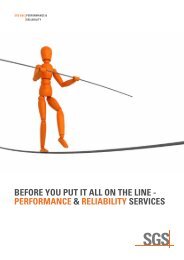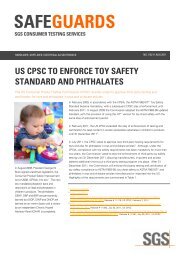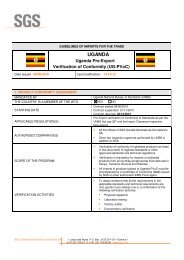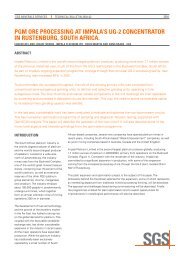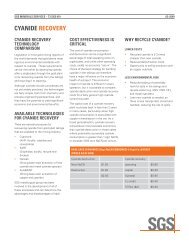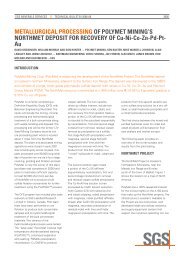Avoiding Failure: Positive Material Identification - SGS
Avoiding Failure: Positive Material Identification - SGS
Avoiding Failure: Positive Material Identification - SGS
You also want an ePaper? Increase the reach of your titles
YUMPU automatically turns print PDFs into web optimized ePapers that Google loves.
36 <strong>Positive</strong> <strong>Material</strong> <strong>Identification</strong><br />
<strong>Avoiding</strong> fAilure<br />
Richard Ritchie, Director at <strong>SGS</strong> Industrial Services says improved positive material<br />
identification is a cost effective way to avoid small problems with huge effects<br />
Richard Ritchie,<br />
Director at <strong>SGS</strong><br />
Industrial Services.<br />
As the common wisdom says, prevention<br />
is better than cure. Asset Integrity<br />
Management Programs not only enable<br />
facilities to keep operating, but also can<br />
extend the life time of assets and facilities.<br />
Systematic inspection, detection and correction<br />
of failure conditions before they occur, or before<br />
they develop into major defects, can avoid<br />
unplanned downtime or even catastrophic<br />
disasters, as well as help reduce maintenance<br />
costs.<br />
Improved <strong>Positive</strong> <strong>Material</strong> <strong>Identification</strong><br />
(PMI) allows plant operators and<br />
maintenance experts to make informed<br />
decisions on non-conforming<br />
components. In most cases, an effective<br />
PMI approach can generate savings far<br />
beyond the cost of the program.<br />
What is PMi?<br />
<strong>Positive</strong> <strong>Material</strong> <strong>Identification</strong> (PMI)<br />
is the determination, with certainty, of<br />
the material in use and the<br />
confirmation that it is the correct<br />
material for the service. Missing or unclear<br />
material certificates, or incorrect materials used<br />
in a service, can increase risk, impacting<br />
maintenance, safety and operations. Each<br />
component material in the wrong service<br />
represents a near miss. PMI is the solution. It<br />
identifies the wrong material in service by<br />
determining the alloy composition of materials<br />
such as stainless steel and high alloy metals.<br />
This can be accomplished either before<br />
beginning plant operation, or after start-up of<br />
operating units. In the latter case, the process<br />
takes place years after commissioning and is<br />
also known as Retro-PMI.<br />
The benefits of Retro <strong>Positive</strong> <strong>Material</strong><br />
<strong>Identification</strong> assessment are substantial<br />
reduction in the risk of catastrophic failure in<br />
operating facilities, protection of employees and<br />
the surrounding community against risk to<br />
health or safety and finally, avoidance of lost<br />
profit due to unscheduled outages.<br />
There are two methods of <strong>Positive</strong> <strong>Material</strong><br />
<strong>Identification</strong>: X-ray refraction and Optical<br />
Emission Spectrography. With the X-ray<br />
Refining & Petrochemicals Middle East July 2010 www.arabianoilandgas.com
Fluorescence (XRF) principle, the fact that each<br />
chemical element emits X-rays at a unique<br />
energy is applied. The XRF equipment contains<br />
radioactive sources, or a low voltage x-ray<br />
generator, which sends out radiation. The<br />
exposed material then temporarily emits<br />
element specific radiation back, generating a<br />
different energy level for every element. This<br />
energy is detected and measured, thus<br />
identifying the alloy elements. The disengaged<br />
radiation is very low and extra safety measures<br />
are not necessary. The important advantage of<br />
the XRF-method is that it can be executed in<br />
service without damaging the material. The<br />
results are available directly after the inspection.<br />
The other method is called Optical Emission<br />
Spectrography (OES). The spectrography<br />
equipment consists of a probe which releases a<br />
spark that is used to vaporize a small amount of<br />
the material being analyzed. The atoms and<br />
ions in this vapor produce a spectrum which<br />
can be optically detected and measured for<br />
calculations to determine the components of<br />
the material. OES instruments are larger in size<br />
and use Argon gas to improve accuracy. It is,<br />
however, the only reliable way to measure<br />
carbon outside of the laboratory.<br />
What are the benefits of improved PMi?<br />
A traditional PMI approach faces several<br />
challenges. It is usually conducted fully or<br />
partially manually, with attendant probability of<br />
human mistakes during the data collection and<br />
data processing. As PMI testing technology has<br />
advanced, improved instrumentation has<br />
become more common, which is generally<br />
combined with software developed specifically<br />
to address PMI issues.<br />
PipeWrxTM for instance is a new and<br />
revolutionary software system meeting the need<br />
for plant operators to detect, record and present<br />
clear and precise information about the asset<br />
integrity. It makes the identification, analysis<br />
and tracking of every single component in every<br />
unit possible, unlike the traditional approach<br />
where only a fraction of components can be<br />
evaluated.<br />
In addition to the productivity improvements<br />
such software provides, the quality and the<br />
reliability of the data processing can be<br />
optimized. Usually every component which<br />
does not meet requirements should be replaced<br />
after identification. However, in some cases,<br />
practice has shown that not all critical<br />
www.arabianoilandgas.com<br />
<strong>Positive</strong> <strong>Material</strong> <strong>Identification</strong><br />
“ImpRoved posItIve mateRIal IdentIfIcatIon<br />
(pmI) allows plant opeRatoRs and<br />
maIntenance expeRts to make InfoRmed<br />
decIsIons on non-confoRmIng<br />
components”<br />
RIchaRd RItchIe, dIRectoR at sgs IndustRIal seRvIces<br />
components call for corrective action. A<br />
material may not meet the engineering<br />
specifications written years ago, but still can<br />
prove to have fitness-for-service.<br />
The fit-for-service assessment is a special<br />
type of appraisal carried out to determine if the<br />
product or installation can fulfill its stated<br />
purpose - typically until the next shutdown - or<br />
if repair or replacement is needed in order to<br />
continue service as specified. When applying<br />
the fit-for-service approach, all potential failure<br />
modes are identified and an assessment is<br />
conducted to ensure that the conditions for<br />
failure are not reached during the intended<br />
operation of the asset. In this way critical<br />
components can be classified as: OK for current<br />
operating conditions, requires monitoring,<br />
replace and flagged for engineering review<br />
Experience reveals that the number of<br />
components needing replacement is<br />
surprisingly low compared to the total amount<br />
of critical components. In some cases corrosion<br />
monitoring must be strengthen or the<br />
engineering specifications must be revised. For<br />
example, a recent retro-PMI assessment<br />
allowed the operator to replace only 3% of the<br />
7% non-conforming components which<br />
represented significant cost and time savings.<br />
An improved PMI approach, in light of<br />
prescribed operating parameters and goals<br />
clearly affects the reliability of the data<br />
collected. It can reduce both the effort needed<br />
for the identification and the cost of remedying<br />
discovered discrepancies by categorizing<br />
discrepancies for corrective action.<br />
The positive contribution of electronic data<br />
management is not limited to data collection<br />
and analysis. Once discrepancies are classified<br />
as to corrective action needed, actionable<br />
reports can be generated. PipeWrxTM enables<br />
improvements in communication, reporting<br />
and assessments to support improved and<br />
actionable decision making to enhance safety,<br />
productivity and profitability.<br />
With state-of-the-art applications which also<br />
can be integrated into standard industry<br />
software, plant operators and maintenance<br />
experts can easily manage inspection and<br />
maintenance planning and reduce the costs<br />
and the effort required for these activities.<br />
PMI is the determination, with certainty, of the material in use and confirmation that it is the correct material for the service.<br />
Refining & Petrochemicals Middle East July 2010<br />
37


